INTRODUCTION
Campaigns add a new dimension to historical miniatures gaming by allowing players to participate in a series of battles which are affected by both the strategic situation and by the outcome of previous actions. This campaign is set during the week of and following the Allied invasion of northern France in 1944. The Longest Week challenges the Allied player to meet or exceed the historical results which allowed the Allies to establish a secure foothold in France and which eventually contributed to the fall of Nazi Germany.
The Longest Week can be played using any 15mm company-level WW2-era rules. Players will need to interpret some of the terminology used here for the specific rules they are using, but for the most part the campaign should be easily adapted to any rules.
CAMPAIGN RULES SUMMARY
A Campaign consists of a series of scenarios, herein called Actions. At the start of the campaign, before any Actions are played, each Player secretly selects one Strategic Option which will influence the forces available during the course of the campaign. Actions are then played in order and are loosely based on tactical situations which were typically encountered in the historical theater of operations. The outcome of each Action can affect the forces that are available for following Actions. Victory Points are awarded based upon the situation at the end of each Action, and the total Victory Points awarded determines the winner of the Campaign.
CAMPAIGN SEQUENCE OF PLAY SUMMARY
At the beginning of each Action, the Players secretly select the forces that will participate in each Action from a list of available Tactical Resources, and then simultaneously reveal their choices. The makeup of the Tactical Resources available for each Action are based upon what resources historically would have been available to the combatants at that phase of the Campaign. Each player must choose a limited number of Tactical Resources from a list, and the number of Tactical Resources that a Player may actually select during an Action is always less than the full list of possible resources. The number and type of Tactical Resources available are also a function of the particular Strategic Option selected and of the outcome of previous Actions as reflected by the Victory Points awarded.
CAMPAIGNED DETAILED SEQUENCE OF PLAY
1. STRATEGIC OPTION SELECTION
Each Player secretly selects ONE Strategic Option and then reveals it simultaneously with the other player. The impact of the particular Strategic Option selected is described below. Some Strategic Options add to the Tactical Resources available for specific Actions, while others may negate the Strategic Option selected by the other Player.
2. ACTIONS.
Actions are played in order using the following sequence of play.
a. Tactical Resource Allocation.
Players refer to Table I. to determine how many Tactical Resources can be selected for this Action. To determine this number, cross-reference the Action being played with the number of Victory Points that have been awarded (only the Allied Player will accumulate Victory Points). The number to the left of the slash ("/") is the number of Tactical Resources that the Allied Player may select, and number to the right is the number the German Player may select.
b. Tactical Resource Selection.
Players secretly select the Tactical Resources from the list in either the German Tactical Resources table (Table 2) or the Allied Tactical Resources table (Table 4). Tactical Resources for each Action can only be selected from the list under the appropriate column for that Action, up to the number determined in step a. above. Each Tactical Resource may only be selected once per Action, although some Tactical Resources consist of the same forces.
Example: German Tactical Resources for an Action are "lx Inf. Plt., Ix Inf. Plt., 1 x HMG Plt., Ix AT Plt., Minefield." The German player determines that only three Tactical Resources are available for this Action, and chooses one of the infantry platoons, the HMG platoon, and the minefield.
Certain Strategic Options make other Tactical Resources available, but do not increase or decrease the actual number of Tactical Resources that may be selected for an Action unless specifically stated in the description of that Strategic Option.
Players simultaneously reveal their Tactical Resources and then roll for troop quality (see Table 3 for the German Player and Table 5 for the Allied player).
c. Set-up.
Prepare the table to model the terrain described in the Map associated with the Action being played, and set-up forces on the table per the instructions in the Action.
d. Play the Action.
Play for the number of turns specified or until one side no longer has effective forces on the table, whichever comes first.
e. Award Victory Points.
Victory Points are awarded to the Allied Player, based on the situation on the table after the designated number of Turns of play. Each Action describes the Conditions that must be met and the Victory Points awarded. The Allied Player is awarded only the highest award for which the Conditions have been met.
Example: At the end of an Action, the Allied Player has cleared the table of German forces and exited a tank platoon off the east edge of the table. The Action states that ten (10) Victory Points are awarded if the table is cleared of German forces, or five (5) Victory Points are awarded if at least one tank platoon exits the east edge of the table before the end of the Action. The Allied Player receives the higher award only, ten (10) Victory Points, for clearing the table of German Forces.
f. Begin next Action.
Go back to step a., unless the last Action has been played.
g. Campaign Victory Determination.
If the last Action has been completed, refer to the Campaign Victory Conditions Rules to determine who won the Campaign.
THE LONGEST WEEK CAMPAIGN RULES
The Longest Week Campaign focuses on the critical days of and after D-Day, during which the Allies struggled ashore on the beaches of Normandy, fought to expand the beachhead, and began the initial build-up that would eventually overwhelm the German defenders. The impetus is on the Allied player to successfully execute the invasion and build-up plans.
ACTIONS
Actions must be played in order. Victory Points are awarded to the Allied Player at the end of each Action based on the outcome. If, at the end of any Action (after awarding Victory Points), the Allied Victory total is 0 or less, the Campaign immediately ends in German Strategic Victory.
Maps represent game boards approximately six by four feet.
Action 1: H-Hour
Allied forces land on the beaches of Normandy and establish a beachhead on D-Day.
Set-up: Map A. German player sets up first on any 10m or higher contour. Allied player sets up second on the beach north of the sea wall (see Special Rules). Allied airborne platoons, if available, may set up anywhere on the map on Turn 1.
Length: 20 Turns
Special Rules:
Allied forces (including airborne) may be placed on the board on Turn 1 or they may be delayed until any later. German forces must begin Turn 1 on the board. The sea wall is impassable to vehicles The Sea is impassable to all troops.
Victory Points
Allied player clears board of German defenders (10)
Allied player has forces south 20m contour line at the end of the last turn (5)
Allied player has forces remaining on the board at the end of the last turn (2) Allied player has no forces remaining on the board at the end of the turn (0).
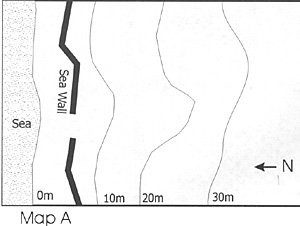
Action 2: Hold Until Relieved.
German forces challenge Allied control of a vital bridge. Length: 16 Turns
Special Rules: The river is impassable to all troops. Woods are heavy and impassable to vehicles. Buildings are wood construction.
Setup: Map B. Allied player sets up with 6" of the bridge. Germans enter Turn I on the road from the south.
Victory Points
Allied player clears table of German attackers (10)
Allied player has forces remaining within 6" of the bridge and no German forces are within 18" of the bridge at the end of the last turn (8)
Allied player has forces remaining within 6" of the bridge (4)
Allied player has forces remaining on the table but none within 6" of the bridge (2)
Allied player has no forces remaining on the board at the end of the turn (0).
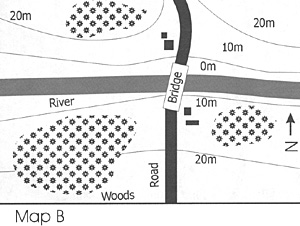
Action 3: Longest Day's Night.
Allied forces attempt to hold against German counterattacks against the fragile Normandy beachhead.
Length: 12 Turns
Special Rules: Turn 1 is daylight. Roll 1D6, daylight remains for that many more turns, and it is night for the remaining turns.
Set-up: Map C. Allied player sets up within 12" of the intersection of the two roads, and/or within 12" of the north edge of the map. Germans enter Turn 1 anywhere along the south end of the map.
Victory Points
Allied player prevents any Germans from exiting off the north edge of the map (10)
German player exits at least one platoon of infantry and/or armor off of the north edge of the map (7)
German player exits at least two platoons of infantry and/or armor off the north edge of the map (0)
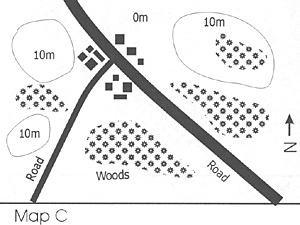
Action 4: Drive Inland.
Allied forces struggle for elbow room on D-Day+1.
Length: 20 Turns
Set-up: Map D. Germans set up first within 18" of the south edge of the map. Allied player enters on Turn 1 on north edge of map.
Victory Points
Allied player clears board of German defenders (10)
Allied player has forces within 6" of the south edge of the map at the end of the last turn (5)
Allied player has forces remaining on the board at the end of the last turn (2) Allied player has no forces remaining on the board at the end of the turn (0).
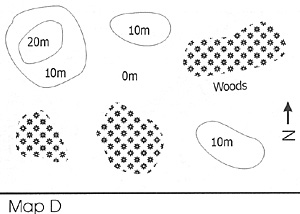
Action 5: Hedgerows from Hell.
Allied forces consolidate early gains and posture for the breakout.
Length: 25 Turns
Special Rules: Hedgerows are impassable to wheeled vehicles. Tracked vehicles must stop on top of hedgerows and move no further until their next turn. If fired upon while atop the hedgerow, count fire from any direction as being against the rear armor.
Setup: Map E. German player sets up first anywhere on the map, but not within 6" of the west edge of the map. Allied player enters from the west edge of the map on Turn 1.
Victory Points
Allied player clears table of German defenders (10)
Allied player exits at least one platoon of infantry or armor off the east edge of the map by the end of the last turn (5)
Allied player has no forces remaining on the board at the end of the turn (0).
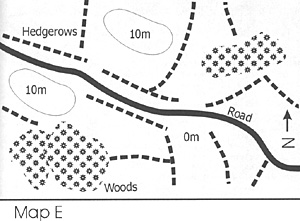
TACTICAL RESOURCES
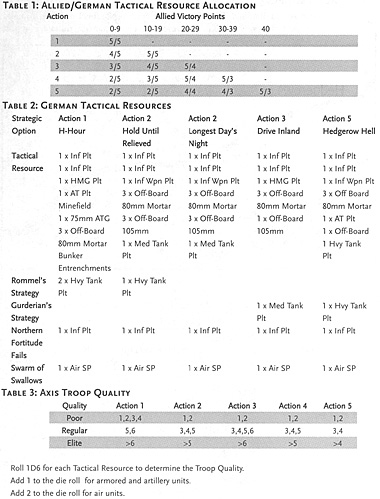 Infantry are organized in platoons (Inf. Plt.) with the appropriate level of leadership and light infantry support weapons (LMG, light mortars, etc.). Heavier infantry support weapons (HMG, heavy mortars, etc.) are organized in weapons platoons (Inf. Weapons Plt.).
Infantry are organized in platoons (Inf. Plt.) with the appropriate level of leadership and light infantry support weapons (LMG, light mortars, etc.). Heavier infantry support weapons (HMG, heavy mortars, etc.) are organized in weapons platoons (Inf. Weapons Plt.).
Armor is organized in platoons of 3-5 tanks.
Naval gunfire and off-board artillery represents the number of fire missions available, and must be successfully called for and diced for accuracy, drift, and possible loss per the rules in use.
Air support must be successfully called before aircraft appear over the table. Aircraft may expend ordnance over multiple turns, but are limited to the total described in the table. Aircraft may strafe.
ALLIED STRATEGIC RESOURCES
1. Transportation Plan.
Prior to the invasion, Allied strategic bombers concentrate on French railways in an effort to prevent the Germans from moving their strategic reserves into the battle for Normandy. German player draws 1 ordinary playing card from a deck of 52 (no Jokers) before each Action after both players have secretly selected and revealed Tactical Resources. If the card is a face card (J, K, Q, or A) then reduce of the number of Tactical Resources available to the Axis in Action 2 and later by one.
2. Oil Plan.
Prior to the invasion, Allied strategic bombers concentrate on German oil production in order to deprive the German of the fuel it desperately needs to keep its mechanized war machine going. German player draws 1 card as above. If that card is a face card, then any German vehicle employed in Actions 3, 4 or 5 must roll for immobilization (a 6 on 1D6) every time it moves. Immobilized vehicles may not move further during the Action in which they become immobilized.
3. Pre-invasion Bombardment.
The Allies initiate massive air and naval attacks on the Normandy area, potentially softening up the defenses but at the same time giving away the location of the invasion. Germans may only select two Tactical Resources for Action 1 (Invasion). Before each of the remaining Actions (before selecting Tactical Resources) the Allied player draws 1 card. If that card is a face card, the number of Tactical Resources available to the German player is reduced by one for that Action. If not a face card, the number of Tactical Resources available to the German player is increased by one for that Action.
4. Operation Double Cross.
Use of German double agents successfully fools Hitler into believing an invasion of Norway is imminent. Selection of this option by the Allied player negates the Axis benefits of Northern Fortitude Fails if that was the choice by the Axis player.
5. Bradley's Airborne Plan.
Omar Bradley planned to drop American airborne divisions behind the beaches to prevent the Germans from moving forward to meet the invasion. George Marshall argued that the Allied airborne divisions should be used far inland to threaten the Germans with "strategic envelopment." Eisenhower intervened and Bradley's plan won out. If selected, the Allied player has additional forces available for Action 1 (see Allied Tactical Resources table).
GERMAN STRATEGIC RESOURCES
1. Northern Fortitude Fails.
The Allies fail to fool the Germans into believing Norway is at risk and the Germans move forces from Norway to Northern France. If selected, the Axis player has additional forces available for Action 1 (see Axis Tactical Resources table). Additionally, the Axis player draws one card before the Tactical Resource selection of each Action. If the card is a face card, then the number of Tactical Resources available to the Axis is increased by one for that Action.
2. Swarm of Swallows.
Hitler comes to his senses and countermands his foolish order to deploy the Me-262 as a bomber. As a result, significant numbers of these new jet fighters allow the Axis to achieve air superiority in skies over Western Europe in the weeks before the invasion. Selection of this option by the Axis player negates the Allied Transportation Plan and Oil Plan Strategic Options. Additionally, the Axis player draws one card before the Tactical Resource selection of each Action. If the card is a face card, the Axis has air support available for that Action.
3. Guderian's Strategy.
Hitler initially supported General Heinz Guderian, who wanted to hold his Panzer divisions back until after the Allies were inland and out of range of their naval gunfire support, and then counterattack to crush the Allies as they attempted to break out of the beachhead.
4. Rommel's Strategy.
The Desert Fox wins his argument with Guderian and Hitler places all armor divisions under Field Marshall Rommel, who plans to use the Panzers to drive the Allied landing off of the beaches on D-Day.
CAMPAIGN VICTORY CONDITIONS
After all Actions have been completed, compare the Allied Victory Points total with the results described below to determine the outcome of the Campaign.
Allied Strategic Victory (37-50 Victory Points)
The historical result. The Allied invasion of Western Europe succeeds and the days of Hitler and his National Socialist Party are numbered.
Allied Marginal Victory (25-36 Victory Points)
The Allied invasion of Western Europe succeeds, but just barely. It will be nearly a year before the Allies break out of Normandy, and Germany finally surrenders only after Truman threatens to use the atomic bomb.
German Marginal Victory (12-24 Victory Points)
The Allied invasion of Western Europe fails but exacts a terrible price on the German defenders. Meanwhile, Stalin's armies drive westward all the way to the Rhine and Hitler commits suicide before the Germans finally capitulate. Nazi Germany is no more, but it is replaced by Soviet Germany.
German Strategic Victory (1-11 Victory Points)
The Allied invasion of Western Europe fails. A new invasion cannot be launched before 1946, but before then the Soviets tire of the titanic struggle against the Wehrmacht and Stalin sues for peace. Hitler moves his Panzers west to Northern France, making invasion impossible. The Allies defeat the Japanese with the A- bomb but are reluctant to use it against the Nazi-Soviet Alliance when Stalin announces the Russians also have the bomb.

Back to MWAN # 131 Table of Contents
Back to MWAN List of Issues
Back to MagWeb Magazine List
© Copyright 2004 Legio X
This article appears in MagWeb.com (Magazine Web) on the Internet World Wide Web.
Other articles from military history and related magazines are available at http://www.magweb.com